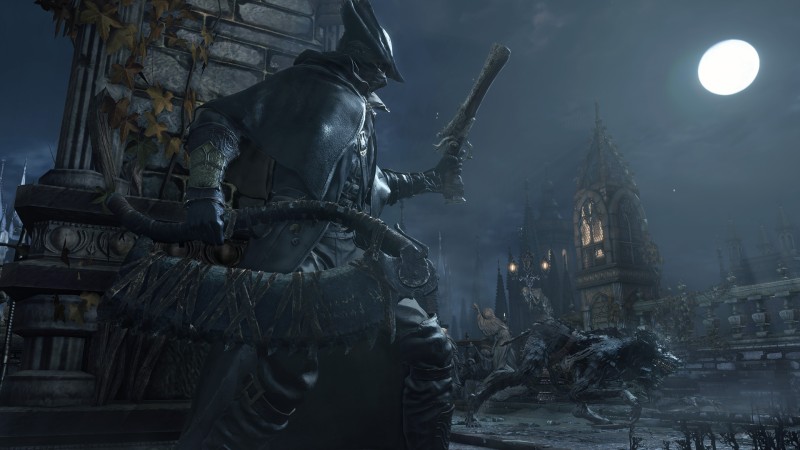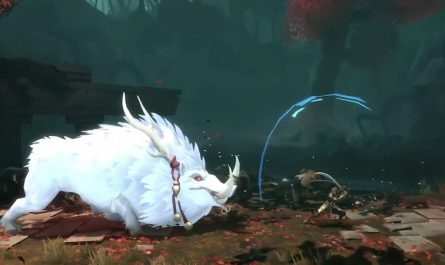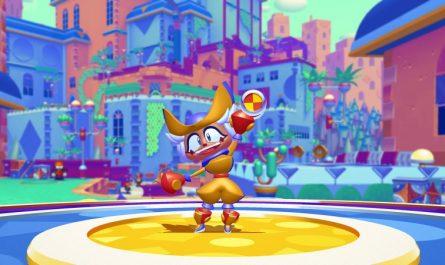Bloodborne arrived on PS4 in 2015 and immediately became one of the best games of the year, earning a 9.75 out of 10 from Game Informer and even taking home our award for Best PlayStation Exclusive. But something about that game has stuck with players. In addition to resonating with a wider audience than many of From Software’s most iconic titles to that point, Bloodborne delivered an engrossing world full of mystery and challenge, causing it to remain top-of-mind for many Soulslike fans even today. In the lead-up to the launch of Elden Ring: Shadow of the Erdtree, I sat down with the creator of Elden Ring, Dark Souls, Sekiro: Shadows Die Twice, Demon’s Souls, and Bloodborne to learn why the 2015 PS4 exclusive holds as special a place in his heart as it does the game’s many fans.
For Miyazaki, who has directed nearly every game in From Software’s legendary Souls catalog (including Elden Ring, Sekiro, and Bloodborne), the relationship between offense and defense started getting more fully fleshed out during the development of Bloodborne. “It’s become something much more fluid and active, I think, which was a very defining characteristic of Sekiro, and it’s something I’ve been thinking about since Bloodborne,” Miyazaki says. “Perhaps in Sekiro, it appears most obviously or its the clearest form that I think that philosophy can embody. And personally, I think there’s one more level we can crank it up to and sharpen that and hone in on that mechanic even more, but I think Sekiro was a big turning point.”
Sekiro: Shadows Die Twice
When I mention that Bloodborne was the first From Software game that clicked with me, Miyazaki smiles. “I’m very glad to hear that,” he exclaims. Bloodborne is a special game for me as well. I’m very, very happy to hear you say that.”
I then follow up, asking the director why the critically acclaimed title sticks out in the vast pool of his other beloved creations. “A couple of reasons,” he begins. “The first one being it was probably one of the most challenging development cycles we’ve had from a studio perspective. The second, perhaps bigger element is how personal it was for me in the sense that I’ve imparted a lot of my own ideas into this game, whether it be story, the world-building component, or even the game mechanics and game systems that are in place. It is perhaps the strongest reflection of my type of flavoring of a game that one can experience.”
However, Miyazaki’s influence is undeniable in the entire From Software catalog, which can likely be attributed to the fact that he has been heavily involved in the stage and level design from Demon’s Souls all the way up to Elden Ring. “My approach of making games as the game director, it’s like sandwiching from a very high, conceptual level and painting the final image of what we’re trying to achieve, as well as going really granular on some of the detailed elements of what the players experience,” he says. “By sandwiching the game development process, the middle almost has only one place to go which is completing that whole experience. Of course, the high-level conceptual stuff might be easy to imagine, but of the details that I pick and choose to oversee myself, the level design is one of them because I think that experience really creates and raises the floor of what players are going to feel and experience through the game design. This is true with Elden Ring and true with Dark Souls as well: I’ll look at what’s being done and say, ‘Alright, this, this, this, and this I’m going to oversee,’ because I know which points in that experience are going to be the most effective and sandwich the high-level vision plus the details that players see.”
Elden Ring
That influence and approach carried into Elden Ring, the latest critically acclaimed From Software title in the Soulslike subgenre. “In the case of Elden Ring, there was the very high-level conceptual vision, and then there were the details,” Miyazaki says. “The defining details for me throughout that game was artwork, the level design, the animation, as well as the text that you see on screen. I think that was the strongest supporting factor that helped elevate the entire experience for players. And because Elden Ring was such a massive experience to design certain levels, we did hand off to other level designers and game designers and I think that is what helps the company grow massively through this experience. Every game has a different set of details that need special attention and one of them that seemed appropriate to work collaboratively or hand off to other designers was the level design in this case. And that, again, I think helps elevate the company as a whole in terms of the talent we have.”
Though Bloodborne and Sekiro are tentpole moments in the evolution of the Soulslike subgenre, Elden Ring is the most successful game in the young category’s history. Not only does it carry an almost unheard-of 96 out of 100 on reviews aggregate site Metacritic (including a rare 10 out of 10 from Game Informer), but it also took home several Game of the Year Awards, including from Game Informer and The Game Awards.
Now, players have an excuse to jump back into that acclaimed 2022 title as From Software is poised to release Shadow of the Erdtree, the long-awaited DLC for Elden Ring. For more on Shadow of the Erdtree, be sure to check out our glowing review of the latest DLC right here.
Bloodborne arrived on PS4 in 2015 and immediately became one of the best games of the year, earning a 9.75 out of 10 from Game Informer and even taking home our award for Best PlayStation Exclusive. But something about that game has stuck with players. In addition to resonating with a wider audience than many of From Software’s most iconic titles to that point, Bloodborne delivered an engrossing world full of mystery and challenge, causing it to remain top-of-mind for many Soulslike fans even today. In the lead-up to the launch of Elden Ring: Shadow of the Erdtree, I sat down with the creator of Elden Ring, Dark Souls, Sekiro: Shadows Die Twice, Demon’s Souls, and Bloodborne to learn why the 2015 PS4 exclusive holds as special a place in his heart as it does the game’s many fans.
For Miyazaki, who has directed nearly every game in From Software’s legendary Souls catalog (including Elden Ring, Sekiro, and Bloodborne), the relationship between offense and defense started getting more fully fleshed out during the development of Bloodborne. “It’s become something much more fluid and active, I think, which was a very defining characteristic of Sekiro, and it’s something I’ve been thinking about since Bloodborne,” Miyazaki says. “Perhaps in Sekiro, it appears most obviously or its the clearest form that I think that philosophy can embody. And personally, I think there’s one more level we can crank it up to and sharpen that and hone in on that mechanic even more, but I think Sekiro was a big turning point.”
Sekiro: Shadows Die Twice
When I mention that Bloodborne was the first From Software game that clicked with me, Miyazaki smiles. “I’m very glad to hear that,” he exclaims. Bloodborne is a special game for me as well. I’m very, very happy to hear you say that.”
I then follow up, asking the director why the critically acclaimed title sticks out in the vast pool of his other beloved creations. “A couple of reasons,” he begins. “The first one being it was probably one of the most challenging development cycles we’ve had from a studio perspective. The second, perhaps bigger element is how personal it was for me in the sense that I’ve imparted a lot of my own ideas into this game, whether it be story, the world-building component, or even the game mechanics and game systems that are in place. It is perhaps the strongest reflection of my type of flavoring of a game that one can experience.”
However, Miyazaki’s influence is undeniable in the entire From Software catalog, which can likely be attributed to the fact that he has been heavily involved in the stage and level design from Demon’s Souls all the way up to Elden Ring. “My approach of making games as the game director, it’s like sandwiching from a very high, conceptual level and painting the final image of what we’re trying to achieve, as well as going really granular on some of the detailed elements of what the players experience,” he says. “By sandwiching the game development process, the middle almost has only one place to go which is completing that whole experience. Of course, the high-level conceptual stuff might be easy to imagine, but of the details that I pick and choose to oversee myself, the level design is one of them because I think that experience really creates and raises the floor of what players are going to feel and experience through the game design. This is true with Elden Ring and true with Dark Souls as well: I’ll look at what’s being done and say, ‘Alright, this, this, this, and this I’m going to oversee,’ because I know which points in that experience are going to be the most effective and sandwich the high-level vision plus the details that players see.”
Elden Ring
That influence and approach carried into Elden Ring, the latest critically acclaimed From Software title in the Soulslike subgenre. “In the case of Elden Ring, there was the very high-level conceptual vision, and then there were the details,” Miyazaki says. “The defining details for me throughout that game was artwork, the level design, the animation, as well as the text that you see on screen. I think that was the strongest supporting factor that helped elevate the entire experience for players. And because Elden Ring was such a massive experience to design certain levels, we did hand off to other level designers and game designers and I think that is what helps the company grow massively through this experience. Every game has a different set of details that need special attention and one of them that seemed appropriate to work collaboratively or hand off to other designers was the level design in this case. And that, again, I think helps elevate the company as a whole in terms of the talent we have.”
Though Bloodborne and Sekiro are tentpole moments in the evolution of the Soulslike subgenre, Elden Ring is the most successful game in the young category’s history. Not only does it carry an almost unheard-of 96 out of 100 on reviews aggregate site Metacritic (including a rare 10 out of 10 from Game Informer), but it also took home several Game of the Year Awards, including from Game Informer and The Game Awards.
Now, players have an excuse to jump back into that acclaimed 2022 title as From Software is poised to release Shadow of the Erdtree, the long-awaited DLC for Elden Ring. For more on Shadow of the Erdtree, be sure to check out our glowing review of the latest DLC right here.Read MoreGame Informer



